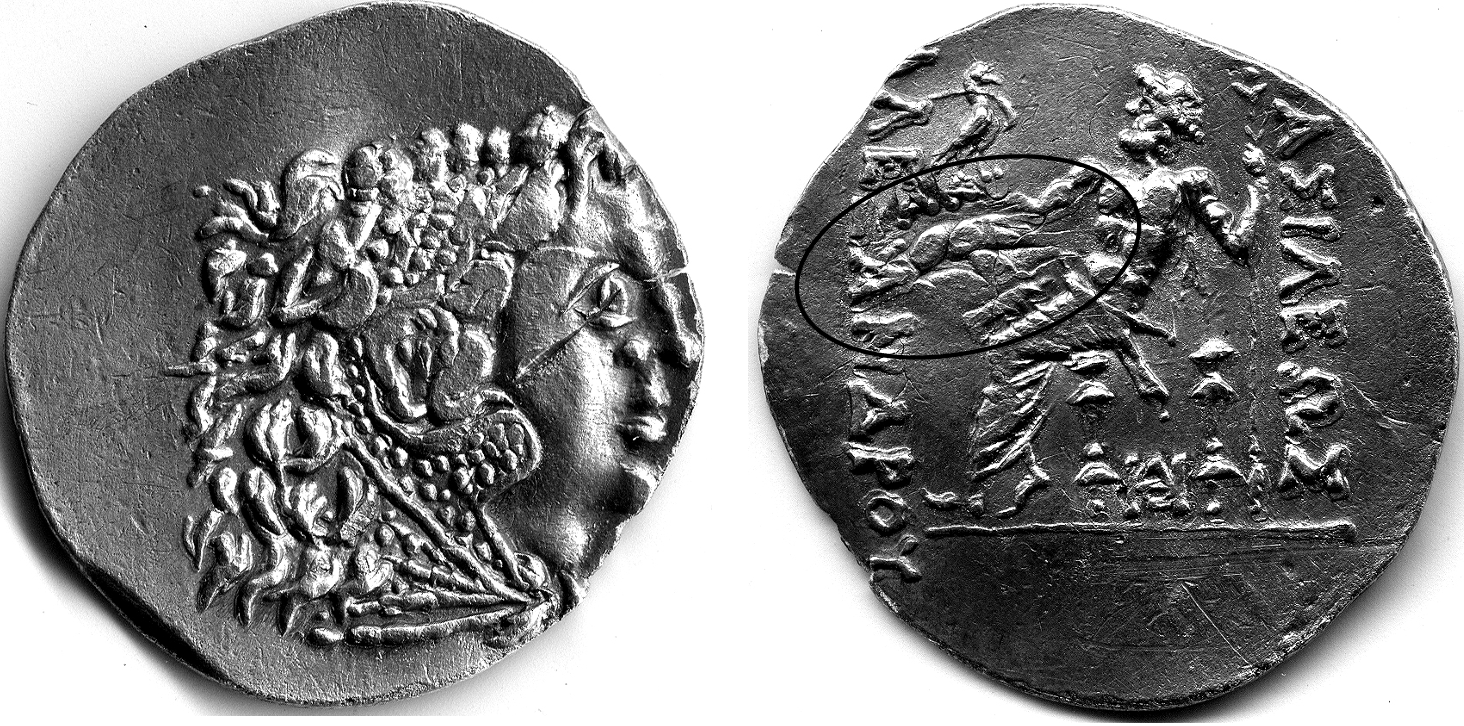3502 - Odessus (Alexander the Great) (tetradrachm Heracles/Zeus) over Thasos (Dionysus/Heracles) (Brussels, KBR, II 82.531): Difference between revisions
From SILVER
No edit summary |
No edit summary |
||
| Line 1: | Line 1: | ||
{{Overstrike | {{Overstrike | ||
|Image overstriking coin=SO 384 - Odessus over Thasos.png | |Image overstriking coin=SO 384 - Odessus over Thasos.png | ||
|Image overstruck variety=Thasos tetradrachm.jpg | |||
|Museum collection=Brussels, Bibliothèque royale de Belgique, II 82.531. | |Museum collection=Brussels, Bibliothèque royale de Belgique, II 82.531. | ||
|Sale=Superior Galleries (30/05/1995), lot 7288. | |Sale=Superior Galleries (30/05/1995), lot 7288. | ||
Revision as of 19:44, 23 May 2023
120 BCE - 90 BCE
Location/history
| Museum collectionMuseum collection: | Brussels, Bibliothèque royale de Belgique, II 82.531. | Sale(s)Sale(s) ᵖ: | Superior Galleries (30/05/1995), lot 7288. |
Overstriking coin
Description
| ObverseInscription or printing placed on the obverse.: | ReverseInscription or printing placed on the reverse.: |
Mint and issuing power
| MintIdentifies the place of manufacture or issue of a numismatic object.: | Odessus | Ancient regionAncient region. | Thrace | Modern countryModern country: Bulgaria | AuthorityIdentifies the issuing power. The authority can be "pretended" when the name or the portrait of X is on the coin but he/she was not the issuing power. It can also be "uncertain" when there is no mention of X on the coin but he/she was the issuing power according to the historical sources: | Alexander III the Great (Argead king, 336-323 BC) |
Chronology
| FromIdentifies the initial date in a range assigned in a numismatic context. 120 BCE toIdentifies the final date in a range assigned in a numismatic context.. 90 BCE | Hellenistic 323-30 BC |
Physical description
| MetalThe physical material (usually metal) from which an object is made.: Silver |
WeightWeight of the numismatic object (in grams). in grams: 16.1716.17 g <br />16,170 mg <br /> | DenominationTerm indicating the value of a numismatic object. Examples: tetradrachm, chalkous, denarius.: tetradrachm |
AxisDescribes the directional relationship between the obverse and reverse of a numismatic object.: 1212 mm <br />1.2 cm <br /> |
| DiameterDescribes diameter of an object (in mm).: 3232 mm <br />3.2 cm <br /> | |||
References
| Coin referenceReference of the Coin: | Callataÿ 2021a, p. 279, n° 5 | Coin series referenceReference to coin series study: | Price 19911Price 1991, n° 1181, Callataÿ 1997a2Callataÿ 1997a, p. 84-87: D14-R42 (fin du Groupe 1), HGC 3.23HGC 3.2, n° 1587, Callataÿ 2021a4Callataÿ 2021a, p. 279, n° 5 |
| Coin series web referenceCoin series web references: | |||
Overstruck type
Description
| ObverseInscription or printing placed on the obverse.: | Wreathed head of Dionysos right | ReverseInscription or printing placed on the reverse.: | HPAKΛEOYΣ ΣΩTHPOΣ / ΘAΣIΩN (Greek) Herakles standing left, holding club and lion skin |
Mint and issuing power
| MintIdentifies the place of manufacture or issue of a numismatic object. ᵖ: | Thasos | Ancient regionAncient region. ᵖ | Thrace | Modern countryModern country: Greece | AuthorityIdentifies the authority in whose name (explicitly or implicitly) a numismatic object was issued. ᵖ: | Roman Republic |
Chronology
| FromIdentifies the initial date in a range assigned in a numismatic context. 160 BCE toIdentifies the final date in a range assigned in a numismatic context.. 90 BCE | Hellenistic 323-30 BC |
Physical description
| DenominationTerm indicating the value of a numismatic object. Examples: tetradrachm, chalkous, denarius. ᵖ: | tetradrachm |
StandardStandard. ᵖ: | Attic |
References
| Coin type referenceReference to coin series study ᵖ: |
Additional data
| Frequency of overstrikesFrequency of overstrikes: | rare and concentrated | Level of confidenceLevel of confidence of the identification: | strong |
| RemarksRemarks: | |||
References
- ^ Price, Martin Jessop (1991), The Coinage in the Name of Alexander the Great and Philip Arrhidaeus: a British Museum Catalogue, 2 vol., Zürich-London, 637 p., 637 p., clix pl.
- ^ Callataÿ, François de (1997), L'histoire des guerres mithridatiques vue par les monnaies, Numismatica Lovaniensia 18, Louvain-la-Neuve, XIII + 481 p. et 54 pl.
- ^ Hoover, Oliver D. (2017), Handbook of Coins of Macedon and Its Neighbors. 3. Part 2: Thrace, Skythia, and Taurike, Sixth to First Centuries BC, Lancaster-London, xix, 232 p.
- ^ Callataÿ, François de (2021), “On pattern and purpose of overstrikes of late Hellenistic tetradrachms in Thrace Macedonia”, in Ulrike Peter and Bernhard Weisser (eds.), Thrace. Local coinage and regional identity, Berlin Studies of the Ancient World 77, Berlin, Topoi, p. 263-289.

